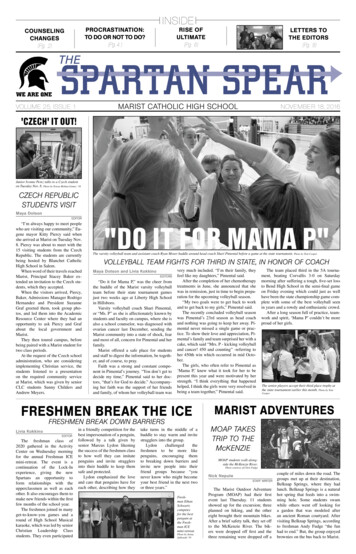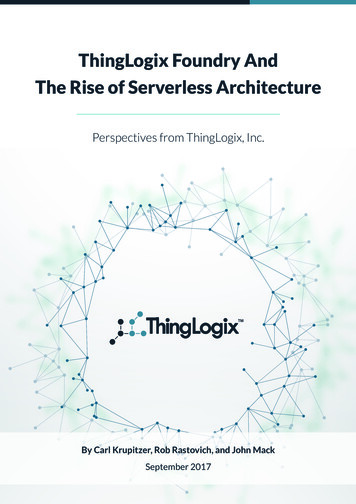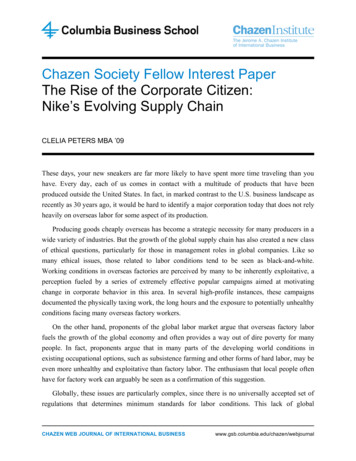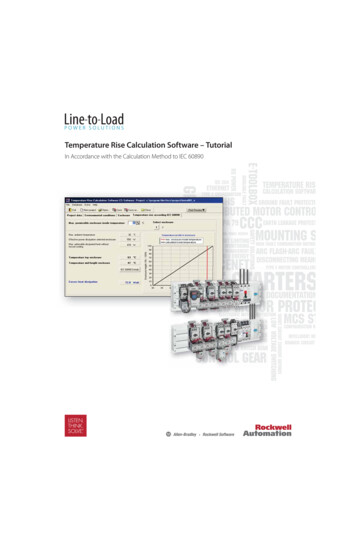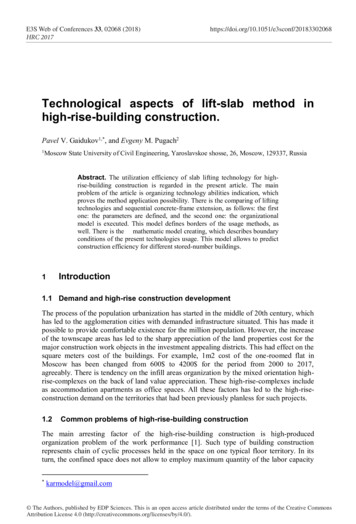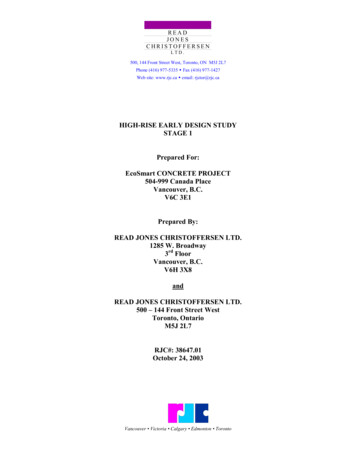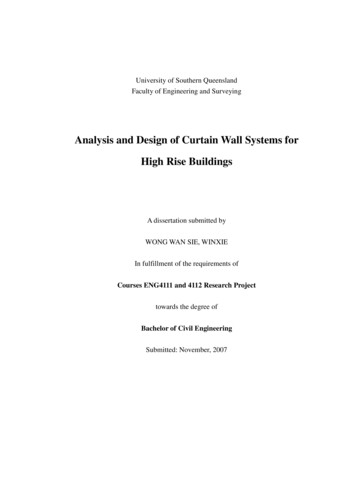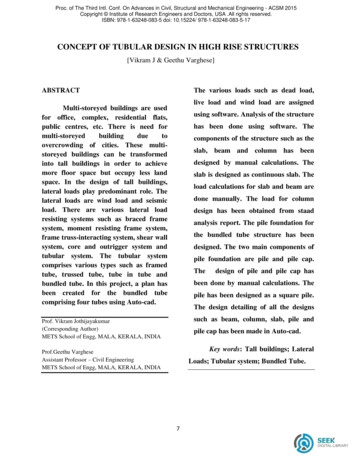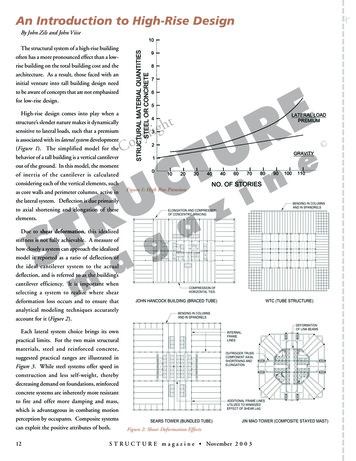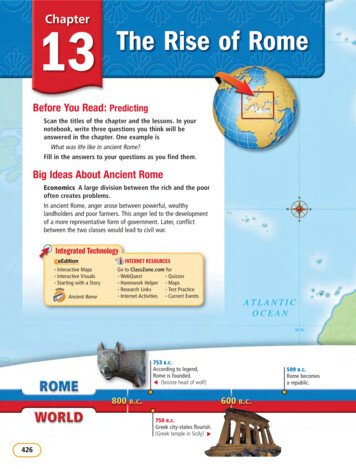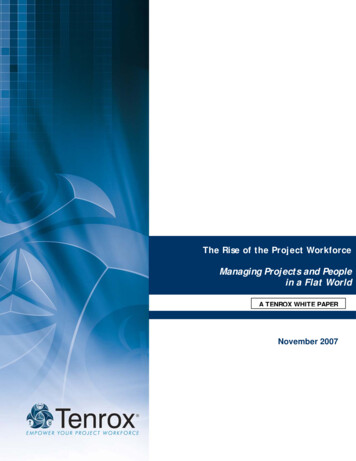
Transcription
The Rise of the Project WorkforceManaging Projects and Peoplein a Flat WorldA TENROX WHITE PAPERNovember 2007
Executive SummaryAs organizations and managers find themselves with two feet plantedfirmly in a fully interconnected, truly global economy, one truth isevident for all enterprises—and particularly for project-drivenbusinesses that rely heavily on project teams and information workers:Our established ways of getting work done, of accounting forthis work, of monitoring compliance, and of analyzing work inprogress for intelligence that will help us do future work faster,better, cheaper and smarter are through. They are no longerenough.In his seminal work Only the Paranoid Survive, then Intel CorporationCEO Andy Grove coined what would become the de facto phrase forpoints in time such as this: strategic inflection points. Strategicinflection points mark full-scale changes in the way business isconducted. The ways we work, the ways we compete, and the wayswe win require a new approach, a new outlook beyond simply makingour existing systems bigger, better, faster. During strategic inflectionpoints, businesses that “get it” and change, achieve unprecedentedgains; those that do not, stumble and fade.Driving our current strategic inflection point is the underlying social,economic and world infrastructure transformation of what globalizationguru, author and Pulitzer Prize winning New York Times columnistThomas Friedman calls a “flat world.” In a flat world, Friedmanexplained to Wired magazine’s Daniel Pink, organizations compete on a“level, global, Web-enabled playing field that allows for multiple formsof collaboration without regard to geography or distance—or soon, evenlanguage.”The problem? Today’s business systems are not designed to plan,schedule, manage, audit and optimize work that gets done in a flatworld.This whitepaper: reviews the market dynamics that are creating our flat world explores the new nature of work in this environment highlights why today’s business and IT systems fall short, and introduces Project Workforce Management, a new breed of systemsdesigned to manage people and projects in a flat world.1 Tenrox, All rights reserved.
The Rise of the Project WorkforceBusiness Must Change in a Flat WorldIn his book The World is Flat Friedman notes that computers, email, fiber opticnetworks, teleconferencing and dynamic software all have irrevocably changed theface of business. Friedman writes, “More people than ever collaborate and competein real-time with more other people, on more different kinds of work, from moredifferent corners of the planet, and on a more equal footing than at any previoustime in the history of the world.”Futurist, trends and innovation expert Jim Carrol concurs in his book What I LearnedFrom Frogs In Texas, writing about what he calls “an era of unprecedented andrelentless change.” As globalization and technological advances converge, Carrolnotes, “Competition is changing overnight, and product lifecycles often last for just afew months. Permanence has been torn asunder. We are in a time that demands anew agility and flexibility: leaders must have the skill and insight to prepare for afuture that is rushing at them faster than ever before.”Globalization, the fragmentation of the enterprise (including the ever-increasing useof outsourcing), and real-time collaboration across the planet have enabledcompanies to reduce costs, leverage a global talent pool and execute challengingdeliverables with a dispersed yet incredibly connected workforce.Regulatory Expansion Adds ComplexityWith the increasing complexity of labor and project work dispersion also has come anunprecedented push toward the protective measures of regulatory oversight andcompliance. Companies are challenged—in this dispersed labor and projectenvironment—to achieve and maintain compliance with regulations such as SarbanesOxley, which directly impact project and workforce management and execution.These shifts are changing the way we work, collaborate and make business decisions.The ways in which we manage work have remained largely the same, while thestructure of our organizations and nature of work have changed radically over thepast several decades.2 Tenrox, All rights reserved.www.tenrox.com
The Rise of the Project WorkforceMarket Dynamics That Challenge Traditional Project ManagementThe following are major market dynamics that not only contribute to the flattening ofthe world, but also challenge the management capabilities of the processes andsystems we use: Globalization. At the start of this shift, organizations moved simple tasks likeassembly and manufacturing to developing countries where this work could becompleted more economically. In globalization’s current wave, organizationsare outsourcing knowledge work as well. The Internet, fast networks and aglobally connected workforce are the driving forces behind this trend. Regulatory scrutiny. As organizations have become more fragmented, theyalso have become subject to greater regulatory scrutiny. In order to comply,they need more thorough and expansive systems for assigning, tracking andmanaging accountability for the work being done. This oversight protectseveryone: workers, customers, suppliers, the organization and its stakeholders. Flattened hierarchy. In a flat world, top-down decision-making is replaced bybottom-up empowerment. Widely-distributed companies cannot use anauthoritative command/control structure. Instead, market leaders will findways to remove the red tape shackles from their project teams and empowerthem to get work done and make local decisions. Fragmented enterprises. Today’s work is defined by atomized segments thatare delivered by specialized workers both inside and outside the company.Organizations assign work to internal or outsourced teams based on costs,available talent, the nature of the work, and customer expectations.A Flat World Demands Collaboration and CooperationThe net result of a flat world is an overriding need for collaboration and cooperation.The problem is that companies are not really all that adept at collaborating; too manyenterprises struggle with thinking innovatively about how they work, and fail tocreate processes and systems that support cooperative collaboration.In What I Learned From Frogs In Texas, Jim Carrol reports the results of a survey byCollaborative Strategies LLC that revealed 32% of the time in a typical working weekis spent on helping others resolve questions. Of these questions, 54% have beenanswered before, yet the answers are not recorded in any type of accessibleknowledge base so that they can be institutionalized. Instead, organizations continueto waste time answering the same questions. This is despite the fact that 81% ofthose in the survey believed it was important to share such knowledge.3 Tenrox, All rights reserved.www.tenrox.com
The Rise of the Project WorkforceOften, the desire to collaborate is not supported by processes and systems that makecollaboration easy, or better yet, a natural part of the way work flows. Instead,entrenched roadblocks and business challenges get in the way. Some are listedbelow. Employees are working very long hours to deliver projects, but managementcannot report on the reasons why resources are so overloaded. As a result,management also lacks the insight to create innovative long-term solutions forbalancing resource demand and resource availability. Businesses lack tangible measures of the value versus effort of differentinternal departments. Manual data collection processes mean management receives reports onbillable utilization and capacity planning after month end—too late to makecorrections on work in process, and too late to take corrective action beforeinitiating new projects. IT or engineering is unable to produce a report that shows the cost breakdownof effort across different types of projects—such as research and development,client and maintenance projects—so that work allocations can be optimized tomeet the organization’s goals. Business reporting comes “after the fact.” Organizations do not havestandardized processes and systems for capturing the details of work. Theyoften use “pillars of disconnected data” that sometimes conflict. For example,they track time using spreadsheets, multiple information systems or multipletimesheet and expense reporting systems (one for payroll, another for projecttracking and another for billable work). The information in these systems doesnot always agree. Managers use manual entry (such as merging spreadsheets)to integrate the data for reporting and decision-making—which consumes timeand people resources, and often results in inaccuracies. Decentralized shared resource pools, spread across business units, cities,countries, and time zones, often have no systems to enable the real-timecollaboration and data access their work requires. Compliance costs are escalating as regulations become more stringent, whilethe way work gets done becomes more fluid. The lack of process automationtied to compliance requirements results in high costs for internal and externalcompliance audits and process re-engineering (training, updatingdocumentation, and developing appropriate reporting methods, for example).4 Tenrox, All rights reserved.www.tenrox.com
The Rise of the Project WorkforceThe New Nature of WorkAt the crossroads of a flat world and the heightened demand for collaborativeorganizations is the new nature of work.Today, work is increasingly differentiated, meaning it is compartmentalized intounits of “subject matter expertise” delivered by collaborating specialized workersboth inside and outside the company. While only a short while ago just 10% of anenterprise’s work was formed around collaborative projects and differentiated time,today about 40% is, and experts expect this to climb to 70% three years from now.This shift in the way work gets done requires organizations to track “differentiatedtime and expenses,” to allocate costs (whether or not they are billable) to the rightprojects, and to examine and justify spending and labor costs across both internal andexternal service units and engineering departments.The flattening of the world and the empowered collaborative workforce has asubstantial impact on how we track and measure work: Work is delivered or centered on an initiative or a project. Companies areable to quickly assemble a team of geographically dispersed, highly specializedprofessionals to execute a specific project. These teams are formed for varyingdurations depending on the nature of the project, and are dismantled just asquickly as initiatives are completed. Some have called this the “HollywoodModel” of work: bring together the best resources to make a movie, thendisband and form other teams to make other movies. It is no longer sufficient to analyze customers, projects, employees andfinancial data as separate entities. These elements are too interdependent tobe tracked by different executives, each using their own tools and policies formonitoring and reporting. A new global system of record is required thatcombines the customer, the talent, and the project.5 Tenrox, All rights reserved.www.tenrox.com
The Rise of the Project WorkforceTraditional Systems Prevent Progress in a Flat World“Inadequate” and “disconnected” describe most of the systems in use today.Traditional Enterprise Resource Planning (ERP) systems fail to provide a single systemof record that unifies customer, project and workforce management. Whether or notthey use an ERP system, most organizations (and all Global 2000 companies) havedeployed multiple enterprise applications and heavy customizations, including but notlimited to: Customer management systems, such as salesforce.com, SalesLogix, MicrosoftCRM, Siebel CRM or other softwares Project scheduling and project collaboration software, such as MicrosoftProject, Primavera, Project KickStart or other systems Portfolio management solutions (such as Primavera or Computer Associate’sClarity) used by internal IT departments to prioritize projects, to conductwhat-if-analysis, and to align projects with company objectives Portal development and document management software such as Microsoft’sSharePoint or Captaris’ Alchemy Time and attendance tracking software, whether ERP customizations orseparate systems from companies such as Kronos or Workbrain Travel and entertainment expense tracking software, whether ERPcustomizations or systems from companies such as Concur or Ariba Billable time tracking software, whether ERP customizations or separatesystems such as Sage Carpe Diem Business process management software (from companies such as Ultimus orLombardi) to automate internal or customer-facing business processesOften these applications have their own databases, rules and policies. Sometimesthey are completely disconnected from the company’s ERP, accounting or payrollsystems. Disconnected systems mean dozens (and in large corporations easilyhundreds) of spreadsheets to track work, to import and export data and to report oncustomers, projects and workers.In addition, spreadsheet-based tracking and reporting is used as “cure all remaininggaps” approach that creates a blizzard of assorted and often conflicting data.Disconnected or manually integrated systems, a mish-mash of unapproved data, and awild email exchange of spreadsheets leads to an environment that is ripe for revenueleakage, errors, fraud and systemic control weakness.6 Tenrox, All rights reserved.www.tenrox.com
The Rise of the Project WorkforceProject Workforce Management: A System for a Flat WorldTo operate effectively, businesses must combine: Human capital management Project management Business process management Cost/revenue accounting into a synthesized solution called Project WorkforceManagement.The underlying business process management workflow in this system adapts to eachprocess, project, business unit and organization. It automates accounting for timeand expenses of a project workforce—both within the company and without, toinclude its service providers. The software can be configured to work the way thecompany does, and fundamentally empowers individuals and decentralizedorganizations.Project Workforce systems enable companies to meet the cooperative collaborationchallenges of a flat world. They establish a new “system of record” that interrelatesthe customer, the project and the workforce (talent) to identify interdependenciesand to simplify priority setting and talent sourcing, while balancing projectprofitability with customer satisfaction. Customer Relationship Management systems(where the “customer” is the system of record), Project Management systems (wherethe “project” is the system of record), and Human Capital Management systems(where the “employee” is the system of record) cannot accommodate theseinterdependencies.Project Workforce Management Identifies InterdependenciesProject Workforce Management links the customer, the project and the talentto create a global system of record.7 Tenrox, All rights reserved.www.tenrox.com
The Rise of the Project WorkforceThe global “projectization” and fragmentation of work in the “flat world” hasresulted in requirements a Project Workforce Management solution fulfills: Project workforce management helps design and oversee the process itself,plus provides real-time visibility into “financial” implications. A ProjectWorkforce Management solution provides the modules that link into a singlesolution—a control “hub”—for total visibility and control. For example:àcost accounting for differentiated time and expensesàproductivity analysisàbudget-versus-actual comparisonsàresource utilization trends, andàsegmented reporting to fully understand the effectiveness and profitabilityof each separate project, resource group, and customer. Change is a constant. Project Workforce Management solutions make it easyfor managers to change processes as they learn more about a project, resourcegroup or customer. Process workflows are depicted graphically, and can bechanged using simple “drag and drop” features. Organizations also canstandardize these changes locally or worldwide if necessary. Work has been broken down into smaller pieces that sometimes overlap:business units, countries, outsourced teams, cost centers, and individualresources must collaborate, cooperate and handle more than one project at atime. A Project Workforce Management solution mirrors this reality bybreaking down work and organizational structure into micro-components thatcan be tracked and summarized in any combination. A Project Workforce Management system provides an interactive environmentfor the real-time tracking and analyzing of project workforce data thatcomplies with established policies and best practices, and enables immediatedecision-making.8 Tenrox, All rights reserved.www.tenrox.com
The Rise of the Project WorkforceProject Workforce Management Plans, Manages and Reports onDifferentiated Work with Interdependent Managementd i f f e r e n t i a t e zationUtilizationi n t e r d e p e n d e n tClient BillingCost AccountingCompletedProjectsw o r lActualm a n a g e m e n tCompliance(SOX, SR&ED,DCAA)Reporting andLearningProject Workforce Management software is designed to plan, manage, track and report on"differentiated work" in an interdependent and holistic way. It helps companies remain competitiveand meet the significant challenges of today's “flat world” business environment.The Underlying Workflow PlatformAll Project Workforce processes are driven by an underlying business processmanagement (BPM) platform. This platform graphically represents people, projectsand financial processes so that workflows can be designed, configured and changed byauthorized managers, without requiring programming resources. The graphicalworkflow interface enables users to visually define, control, track and auditapprovals, routing, role-based assignments and notifications. All business processesuse the same graphical workflow concepts and management interface. By leveragingthe same visual framework and concepts, users experience a consistent and intuitiveWeb interface that is easy to learn and use.9 Tenrox, All rights reserved.www.tenrox.com
The Rise of the Project WorkforceThe FunctionsProject Workforce Management centrally manages project workforce related data,eliminating many of the spreadsheets used to track projects, time and labor,expenses, interdepartmental charge backs, and billable work. Project WorkforceManagement encompasses and integrates: Time and Expense Tracking: Tracks all differentiated time and expenses,whether or not they are billable. Cost and Revenue Accounting: Attributes all revenue (and charge back),spending and labor costs to specific projects, and establishes a formal chargeback system for shared service departments such as IT and engineering.Formalizes and enforces a revenue accounting and recognition policy that is incompliance with regulations. Produce customer invoices, or charge back otherbusiness units, on a project basis for all billable work, spending and laborcosts; or invoices based on a pre-defined billing schedule. Workforce Planning: Handles competency and capacity planning. Optimallyschedules your workforce by locating the most optimal available resources toaccomplish specific roles in a project.10 Tenrox, All rights reserved.www.tenrox.com
The Rise of the Project Workforce Project Process Management: Manages project processes, including projectinitiation, risk and issue reporting, and scope control using policy-based andenforced best practices. Analytics: Provides a consolidated, real-time and dynamic view of thecompany's projects, processes and workforce, with a special emphasis onrepor
A TENROX WHITE PAPER The Rise of the Project Workforce Managing Projects and People . enterprise’s work was formed around collaborative projects and differentiated time, . Portal develop
